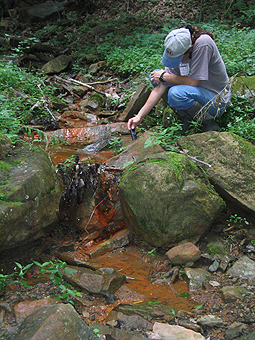The National
Fish Habitat Board listed these two projects, Williams Run, Pennsylvania,
and Aaron Run, Maryland,
among its “10 Waters to Watch” for 2008. Each year, the board selects 10
projects as the “best of the best” in innovation, results, and effective
partnerships. The projects receive support
from the combined efforts of OSM’s Watershed Cooperative Agreement Program and
a coalition of government and private-sector partners. The Aaron Run project, near Frostburg, Md., stems flows of acid-mine drainage into
a tumbling mountain stream. There conservation partners are re-establishing
four miles of native brook trout habitat. The Williams Run Project, about an hour
north of Pittsburgh, Pa., works to restore nine miles of
Appalachian stream for brook trout by treating acid-mine drainage. The projects are
representative of waters across the country that are improving through the
conservation efforts of the National Fish Habitat Action Plan. This state-led
initiative works to reverse persistent declines in aquatic habitat through
regional partnerships. Both projects will treat
drainage from abandoned coal mines to restore native brook trout to watersheds
where the species had ceased to exist many decades ago. The Eastern Brook Trout Joint Venture, a
regional partnership of the National Fish Habitat Action Plan, is providing financial
and technical assistance. “We are pleased that Abandoned Mine Land
projects are receiving this recognition from national conservation experts,”
said Brent Wahlquist, director of OSM.
“The states and tribes have done a tremendous job of restoring mined
lands and watersheds over the last 30 years.
Many of their projects have direct benefits to fish populations
downstream. Brook trout historically
inhabited most of the headwaters streams in Pennsylvania
and western Maryland. The resurrection of this key species is
important both as an indicator of water quality and to recreational anglers." “The Eastern
Brook Trout Joint Venture is excited by the local partnerships that have been
established to restore brook trout habitat in Aaron Run and Williams Run, two
streams that have been severely impacted by acid mine drainage,” said Stephen Perry, EBTJV
chairman and chief of the Inland Fisheries Division of the New Hampshire Fish
and Game Department. “AMD has
been identified as a major but reversible impact to brook trout habitat in the Mid-Atlantic states. We are pleased to be working
with OSM and other partners to restore AMD-damaged streams so that they once
again support viable populations of brook trout. These two projects
highlight the power of the National Fish Habitat Action Plan, as we move
towards making our waterways healthy for fish.” Profiles of the
Aaron Run and Williams Run projects may be found at the National Fish Habitat
Action Plan’s Web site, www.fishhabitat.org/. OSM carries out
the requirements of the Surface Mining Control and Reclamation Act in
cooperation with states and Indian tribes. OSM's primary objectives are as follows:
"Our approach — teaming federal, state and local partners — is helping to
make these waters better … faster," said Kelly Hepler, vice-chair of the
National Fish Habitat Board. Hepler made his remarks from the banks of the Potomac River at the National Casting Call, an annual
event highlighting fisheries conservation and recreational-fishing heritage.
"By watching these 10 examples of our nation’s conservation efforts, we can see real progress in treating the
causes of fish habitat decline, not just the symptoms."
Contents
Bureau News
More About Interior



 Print Version
Print Version
 E-mail This Article
E-mail This Article
